Search Results
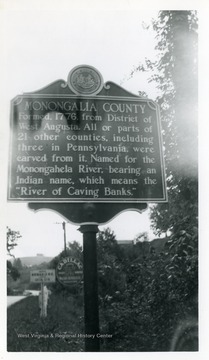
- IDNO:
- 031318
- Title:
- Monongalia County Marker on U. S. Route 19 at the West Virginia and Pennsylvania State Line
- Date:
- 1951
- Description:
- Monongalia County: Found 1776 from District of West Augusta. All or parts of 21 other counties, including three in Pennsylvania were carved from it. Named for the Monongahela River bearing an Indian name, which means the "River of Caving Banks."
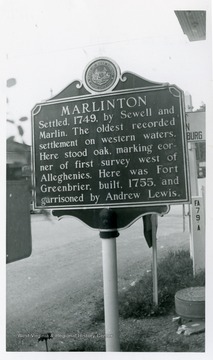
- IDNO:
- 031319
- Title:
- Marlinton Marker on U. S. Route. 219, Pocahontas County, W. Va.
- Date:
- 1952
- Description:
- Marlinton: Settled 1749 by Sewell and Marlin. The oldest recorded settlement on western waters. Here stood oak, marking corner of first survey west of Alleghenies. Here was Fort Greenbrier, built, 1755, and garrisoned by Andrew Lewis.
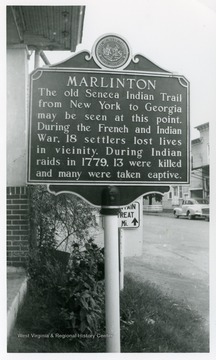
- IDNO:
- 031320
- Title:
- Marlinton Marker, Pocahontas County, W. Va.
- Date:
- 1952
- Description:
- Marlinton: The old Seneca Indian Trail from New York, to Georgia may be seen at this point. During the French and Indian War, 18 settlers lost lives in vicinity. During Indian raids in 1779, 13 were killed and many were taken captive.
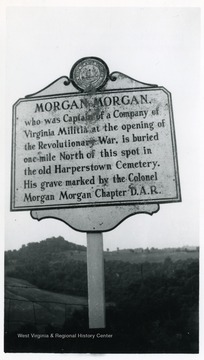
- IDNO:
- 031321
- Title:
- Morgan Morgan Marker on State Rt. 73, Between Morgantown and Fairmont, W. Va.
- Date:
- 1951
- Description:
- Morgan Morgan: who was Captain of a Company of Virginia Militia at the opening of the Revolutionary War, is buried one mile North of this spot in the old Harperstown Cemetery. His grave marked by the colonel Morgan Morgan Chapter D. A. R.
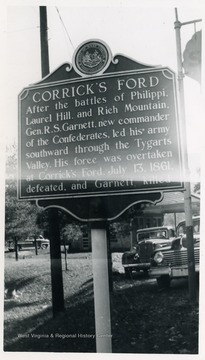
- IDNO:
- 031322
- Title:
- Corrick's Ford Marker, Parsons, W. Va.
- Date:
- 1951
- Description:
- Corrick's Ford: After the battles of Philippi, Laurel Hill and Rich Mountain. Gen. R. S. Garnett, new commander of the Confederates, led his army southward through the Tygarts Valley. His force was overtaken at Corrick's Ford, July 13, 1861 defeated and Garnett killed.
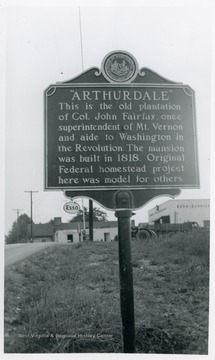
- IDNO:
- 031323
- Title:
- Arthurdale, Marker on State Route 92, Preston County, W. Va.
- Description:
- Arthurdale: This is the old plantation of Col. John Fairfax, once superintendent of Mt. Vernon and aide to Washington in the Revolution. The mansion was built in 1818. Original Federal homestead project here was model for others.
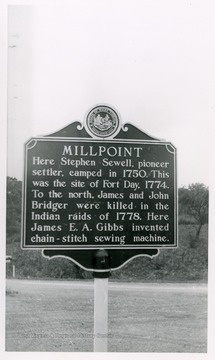
- IDNO:
- 031324
- Title:
- Millpoint Marker on U. S. Route 219, Pocahontas County, W. Va.
- Date:
- 1952
- Description:
- Millpoint: Here Stephen Sewell, pioneer settler, camped in 1750. This was the site of Fort Day, 1774. To the north, James and John Bridger were killed in the Indian raids of 1778. Here James E. A. Gibbs invented chain-stitch sewing machine.
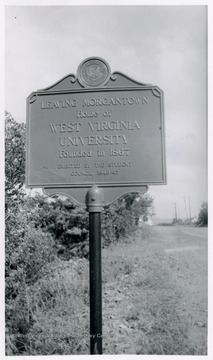
- IDNO:
- 031363
- Title:
- Historic Marker at Dorsey 's Knob on Route 119 Near Morgantown, W. Va.
- Date:
- 1955
- Description:
- 'Leaving Morgantown, Home of West Virginia University. Founded in 1867, Erected by Student Council 1946-47'
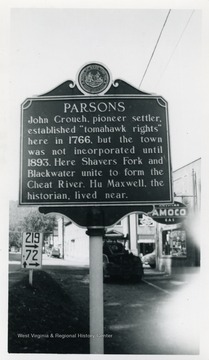
- IDNO:
- 031364
- Title:
- Historic Marker in Parsons, W. Va.
- Date:
- 1951
- Description:
- 'Parsons- John Crouch pioneer settler established "tomahawk rights" here in 1766, but the town was not incorporated until 1893. Here Shavers Fork and Blackwater unite to form the Cheat River. Hu Maxwell, the historian, lived near.'
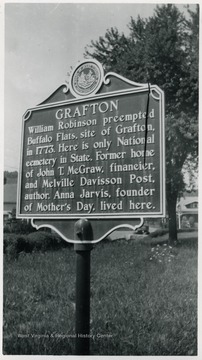
- IDNO:
- 031366
- Title:
- Historic Marker on U.S. Route 50, Grafton, W.Va.
- Date:
- 1951
- Description:
- 'William Robinson preempted Buffalo Flats, site of Grafton,in 1773. Here is only National cemetery in State. Former home of John T. McGraw, financier, and Melville Davisson Post, author. Anna Jarvis founder of Mother's Day, lived here.

- IDNO:
- 031369
- Title:
- Historic Marker in Elkins, W. Va.
- Date:
- 1951
- Description:
- 'Named for Senator Stephen B. Elkins. Home of Senator Henry G. Davis. Headquarters for the Monongahela National Forest. Near site of Friend's Fort, built in 1772. Old Seneca Indian Trail crosses the campus of Davis and Elkins College.'
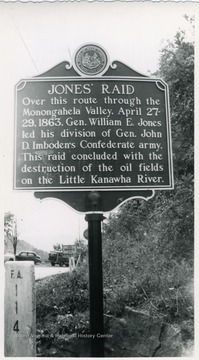
- IDNO:
- 031374
- Title:
- Jones Raid Marker on U. S. Route 19 at Monogahela and Marion County Line
- Date:
- 1951
- Description:
- 'Over this route through the Monongahela Valley, April 27-29, 1863, Gen. William E. Jones led his division of Gen. John D. Imboden's Confederate army. This raid concluded with the destruction of the oil fields on the Little Kanawha River.'